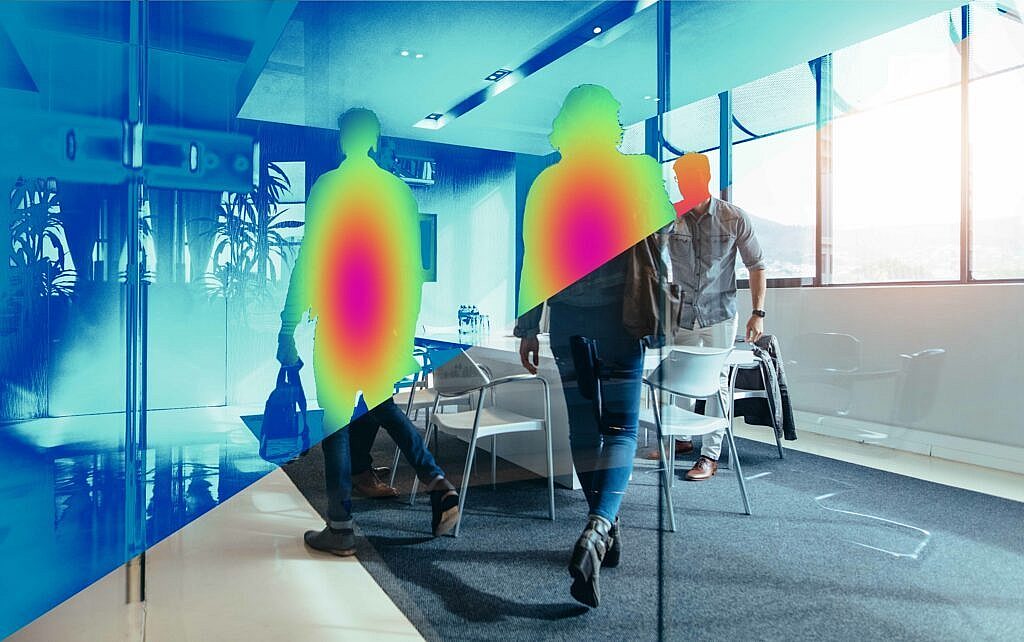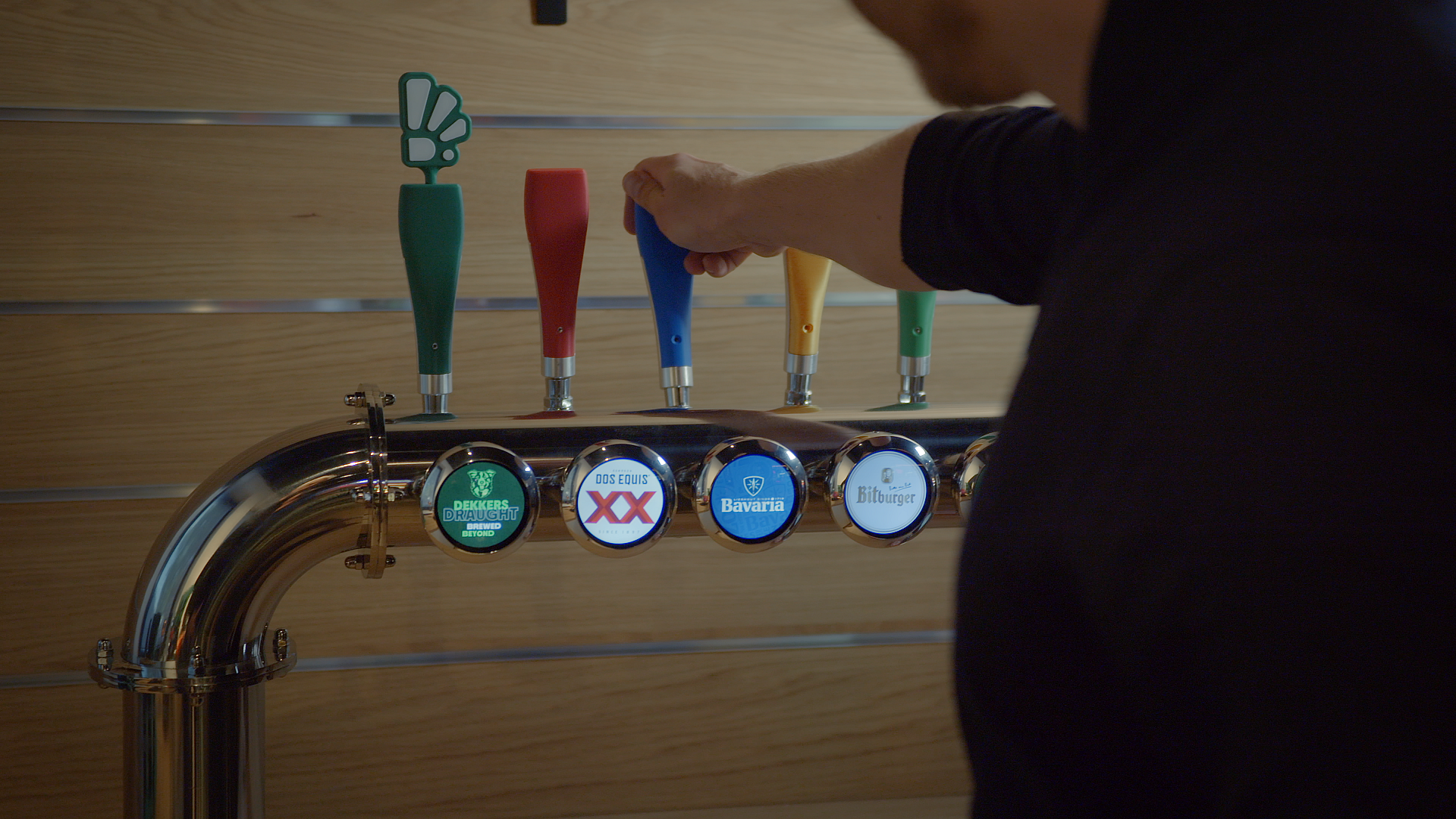KPN und Calumino arbeiten im Manufacturing Fieldlab gemeinsam an einem allgemein einsetzbaren Wärmebildsensor
Das Scaleup-Unternehmen Calumino hat einen bahnbrechenden Wärmebildsensor entwickelt, der von KPN angeschlossen wurde. "Unser Sensor verfügt über eine Reihe einzigartiger Merkmale, die ihn sehr gut für die Schädlingsbekämpfung und die Erfassung von Personen geeignet machen", sagt Bart de Jong, kaufmännischer Leiter von Calumino. Diese Lösung wird im KPN Manufacturing Fieldlab in Eindhoven vorgeführt.
Wärmesensoren bieten einen einzigartigen Blick auf unsere Welt, da sie Wärme statt Licht messen. In Kombination mit der KI-Technologie der Computer Vision haben Wärmesensoren das Potenzial, die Art und Weise zu revolutionieren, wie wir unsere Lebens- und Arbeitsumgebung verwalten, überwachen und sichern.
Der Calumino Thermal Sensor kombiniert hohe Leistung mit KI, Schutz der Privatsphäre und Erschwinglichkeit.
Bestehende Sensoren zur Erkennung von Menschen und Tieren haben klare Nachteile. So verletzen beispielsweise visuelle Kameras die Privatsphäre, Bewegungssensoren sind "nicht intelligent" und Radartechnologien sind komplex. Der neue Wärmebildsensor von Calumino löst diese Herausforderungen durch seine geringe Auflösung, eingebettete Analytik und Erschwinglichkeit.
Gemeinsam innovativ sein
Im KPN Manufacturing Fieldlab auf dem Brainport Industries Campus in Eindhoven experimentieren KPN und Partner mit neuen Technologien wie 5G, präziser Lokalisierung und Edge Computing. "In unserem Fieldlab arbeiten wir an Anwendungsfällen, die den Digitalisierungsthemen in der Fertigungsindustrie Substanz verleihen", sagt Paul Cobben, Sector Developer for Manufacturing bei KPN Corporate Market. Diese Anwendungsfälle basieren auf einer sicheren Anwendungsinfrastruktur, die aus drei Kernbausteinen besteht: einem 5G-Netzwerk, einer präzisen Lokalisierungstechnologie und Edge Computing vor Ort. Gemeinsam mit unserem Branchenpartner Calumino entwickeln wir relevante Beispiele und Anwendungen, die Unternehmen mit greifbaren Beispielen zur Untermauerung ihrer Smart Industry-Strategie versorgen."
Datenschutz und Markteinführungszeit
Mit einer nativen niedrigen Auflösung von etwa 500 Pixeln löst der Calumino-Sensor ein Problem, das vielen Unternehmen Sorgen bereitet: die Privatsphäre. "Da unser Sensor Wärme statt Licht sieht, erscheinen Personen als heiße Kleckse vor dem Hintergrund", erklärt De Jong. "Anhand der Form, Größe und Bewegung eines Kleckses können wir feststellen, ob es sich um eine Person, ein Tier, ein Objekt oder einen Hotspot handelt. Und wenn wir eine Person erkennen, können wir nicht feststellen, wer diese Person ist. Wir können höchstens zwischen einem Erwachsenen und einem Kind unterscheiden. Die Privatsphäre ist dann kein Thema mehr.
Ein weiterer großer Vorteil ist, dass Unternehmen den Calumino-Sensor einfach in ihr Endprodukt integrieren können. "Der Sensor verfügt über einen eingebetteten Prozessor, der die Bilder mit unseren selbst entwickelten Computer-Vision-Algorithmen analysiert", sagt De Jong. "Diese grundlegenden Algorithmen machen es den Kunden sehr einfach, unsere Technologie zu evaluieren und einzusetzen. Wir sind der einzige Hersteller, der diese Algorithmen auch liefert, sodass unsere intelligenten Sensoren die Zeit bis zur Markteinführung erheblich verkürzen."
De Jong sagt, dass der Calumino-Sensor für eine Vielzahl von Anwendungen eingesetzt werden kann:
- Gebäudeverwaltung
Die Sensoren helfen, Gebäude energieeffizient zu machen. "Auf der Grundlage einer Echtzeit-Wärmekarte und der Anzahl der Personen in einem Raum können unsere Nutzer die Klimaanlage und die Beleuchtung optimieren. Natürlich kann man die Menschen auch mit einer visuellen Kamera zählen, aber dann ist der Datenschutz ein Problem. Die Hersteller sagen oft, dass niemand auf die Daten zugreifen kann und dass die Daten nicht in die Cloud gehen. Tatsache ist jedoch, dass eine visuelle Kamera sensible persönliche Daten aufzeichnen kann. Ein Bewegungssensor beeinträchtigt die Privatsphäre nicht, aber er ist auch nicht intelligent.
- Schädlingsbekämpfung
Der Calumino-Sensor kann auch kleine Tiere wie Ratten und Mäuse erkennen. Damit eignet sich der Sensor sehr gut für die Überwachung und Bekämpfung von Schädlingen. "Unser Sensor gibt Aufschluss darüber, wie groß das Schädlingsproblem an einem bestimmten Ort ist und ob die Bekämpfungsmaßnahmen Wirkung zeigen. Auch in diesem Markt gibt es für Calumino viele Möglichkeiten. Wir arbeiten bereits mit verschiedenen Schädlingsbekämpfungsunternehmen in der ganzen Welt zusammen, die unsere Technologie in ihre Produkte integrieren."
- Gesundheitswesen
Gesundheitseinrichtungen können den Sensor zur Überwachung älterer Menschen einsetzen, ohne deren Privatsphäre zu verletzen. "Nach einem Sturz liegen die Menschen manchmal viele Stunden auf dem Boden. Daher kann man solche schwierigen Situationen leicht im Auge behalten. Es ist auch möglich, das Schlafverhalten zu überwachen. Wenn jemand unerwartet zu seltsamen Zeiten aufsteht, könnte das bedeuten, dass etwas nicht in Ordnung ist. Man kann auch die Einsamkeit bekämpfen, indem man zum Beispiel Maßnahmen ergreift, wenn ein Klient ständig allein auf seinem Stuhl sitzt."
- Brandsicherheit
Der Calumino-Sensor ist auch eine intelligentere Alternative zu Rauchmeldern. "Ein Rauchmelder braucht 7 bis 8 Minuten, um vor einem Feuer zu warnen, denn es muss erst genügend Rauch vorhanden sein. Unser Sensor schaut nicht auf das Licht, sondern auf die Wärme und erkennt hohe Temperaturen sofort. Das spart enorm viel Zeit. Außerdem gibt der Sensor den Feuerwehrleuten nützliche Informationen. Selbst bei starker Rauchentwicklung können sie zum Beispiel sehen, wo sich Menschen befinden, die evakuiert werden müssen."
- Sicherheit
Calumino arbeitet an einer Reihe von Anwendungen im Bereich der Sicherheit und Zugangskontrolle. "Eine der Möglichkeiten, den Sensor zu nutzen, ist die kontinuierliche Überwachung von Sperrbereichen in Unternehmen oder Rechenzentren. Unser Sensor kann auch zur Sicherung von ‚beweglichen‘ Objekten wie Anhängern verwendet werden. So können Sie Diebstahl und Menschenschmuggel verhindern."
Zuverlässiges Netz
Der Sensor nutzt derzeit eine 4G-Mobilfunkverbindung. Das hat mehrere Vorteile, sagt De Jong. "Das KPN-Netz ist zuverlässig und hat eine hervorragende Reichweite. Dies bietet eine Lösung für industrielle Umgebungen, in denen das Wi-Fi-Signal nicht überall stark ist. Zudem ist eine 'autonome' Verbindung oft praktischer als ein lokales Netz, weil man sich nicht mit der IT-Abteilung des Kunden abstimmen muss. Manchmal ist die mobile Konnektivität die einzige Option. Ein Beispiel dafür sind Anhänger, die ständig in Bewegung sind.
Mobile World Congress und Arbeitsgruppe Industrielles IoT
Die Zusammenarbeit mit Innovationspartnern wie Calumino ermöglicht Ihnen den Zugang zu den größten Veranstaltungsorten. "Auf dem Mobile World Congress hatte KPN die Gelegenheit, eine bedeutende Präsentation zum Thema der Beziehung zwischen Mensch und Maschine zu halten; Calumino diente als konkretes Beispiel dafür. Das führte schließlich zu einem weiteren wertvollen Pitch bei einer wichtigen GSMA-Arbeitsgruppensitzung für Branchenführer in Toulouse", erklärt Cobben.
Die Partnerschaft mit KPN ist für Calumino sehr wertvoll. "Und das nicht nur, weil KPN dafür sorgt, dass unser Sensor immer verbunden ist", betont De Jong. "KPN hat viele Kunden, die an unserer Plattformtechnologie interessiert sind. Außerdem verfügt KPN über ein umfangreiches Netzwerk strategischer und anderer Partner, von dem wir profitieren. In diesem Zusammenhang hatten wir das Glück, eine gemeinsame Präsentation mit KPN im Airbus-Werk in Toulouse zu halten. Was für eine tolle Gelegenheit!"
Der kaufmännische Leiter ist dankbar für die Unterstützung durch KPN. "Es ist großartig, dass ein großes Unternehmen wie KPN so viel Vertrauen in unsere Technologie hat. Wir freuen uns darauf, die IoT-Herausforderungen unserer Kunden in Angriff zu nehmen. Mit der Kombination aus 5G, Edge- und Cloud-Computing und unserem Sensor sind die Möglichkeiten endlos."
Möchten Sie wissen, wie KPN für Ihr Unternehmen von Nutzen sein kann? Nehmen Sie unverbindlich Kontakt mit uns auf. Wir helfen Ihnen gerne weiter!




